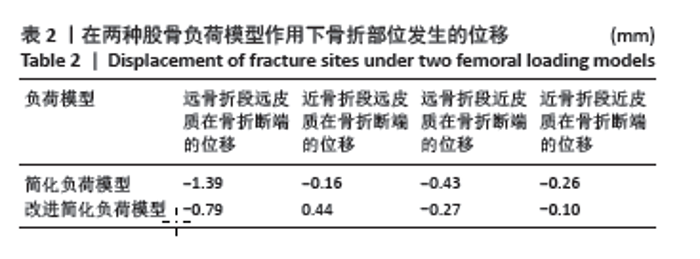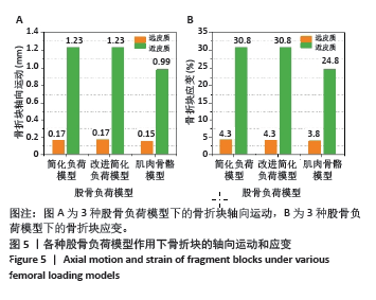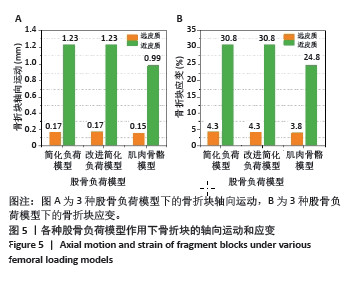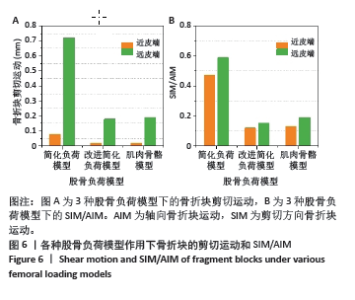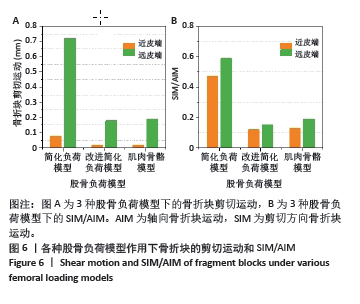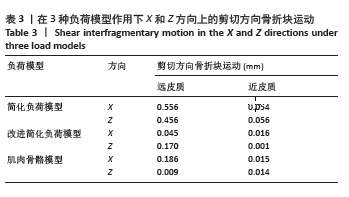Chinese Journal of Tissue Engineering Research ›› 2025, Vol. 29 ›› Issue (21): 4413-4420.doi: 10.12307/2025.814
Previous Articles Next Articles
Finite element analysis of muscle loading effect on biomechanics of early healing of femoral stem fractures
Cheng Chaoran1, Zhang Junxia1, 2, Jia Jun3
- 1College of Mechanical Engineering, Tianjin University of Science and Technology, Tianjin 300222, China; 2Tianjin Key Laboratory of Integrated Design and Online Monitoring for Light Industry and Food Engineering Machinery and Equipment, Tianjin University of Science and Technology, Tianjin 300222, China; 3Department of Orthopedics, Tianjin Hospital, Tianjin 300200, China
-
Received:2024-05-13Accepted:2024-07-31Online:2025-07-28Published:2024-12-04 -
Contact:Zhang Junxia, MD, Professor, College of Mechanical Engineering, Tianjin University of Science and Technology, Tianjin 300222, China; Tianjin Key Laboratory of Integrated Design and Online Monitoring for Light Industry and Food Engineering Machinery and Equipment, Tianjin University of Science and Technology, Tianjin 300222, China Corresponding author: Jia Jun, MD, Chief physician, Department of Orthopedics, Tianjin Hospital, Tianjin 300200, China -
About author:Cheng Chaoran, Doctoral candidate, College of Mechanical Engineering, Tianjin University of Science and Technology, Tianjin 300222, China -
Supported by:Tianjin Science and Technology Plan Project, No. 20JCYBJC01430 (to JJ)
CLC Number:
Cite this article
Cheng Chaoran, Zhang Junxia, Jia Jun. Finite element analysis of muscle loading effect on biomechanics of early healing of femoral stem fractures[J]. Chinese Journal of Tissue Engineering Research, 2025, 29(21): 4413-4420.
share this article
Add to citation manager EndNote|Reference Manager|ProCite|BibTeX|RefWorks
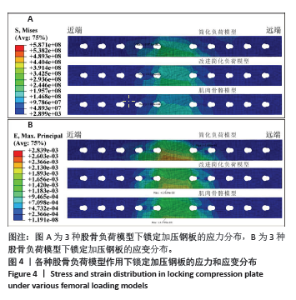
虽然简化负荷方法和改进简化负荷方法的边界条件略有不同,但其作用力都来源于人体质量,作用在股骨上的轴向力对骨折块运动的作用形式相同,致使在股骨轴向产生的AIM值也近似相同,验证了数据库“OrthoLoad”中测量数据和AMS获取的负荷模型的一致性和有效性。 2.2 锁定加压钢板的应力和应变 3种负荷模型计算的锁定加压钢板的Von Mises应力和最大应变有显著差异。Von Mises应力分布如图4A所示。随着股骨负荷模型的简化程度的增大,锁定加压钢板的最大Von Mises应力逐渐增大,肌肉骨骼方法、改进简化负荷方法和简化负荷方法3种方法中得到的锁定加压钢板的最大Von Mises应力分别为399.8,480.3,587.1 MPa。肌肉骨骼方法得到的最大应力比简化负荷方法得到的小31.9%,比改进简化负荷方法得到的小16.8%。锁定加压钢板的最大应变如图4B所示,简化方法、改进简化方法和肌肉骨骼方法得到的锁定加压钢板的最大应变分别为2 839,2 024,1 735 με。即肌肉骨骼方法得到的最大应变比简化负荷方法得到的最大应变小38.9%,比改进简化负荷方法得到的最大应变小14.3%。结果表明,采用传统简化股骨负荷方法会高估锁定加压钢板的应力应变,忽略肌肉负荷则高估锁定加压钢板的应力应变。 对于3种负荷建模,改进简化负荷模型和肌肉骨骼模型的最大应力分布在股骨近侧且最靠近骨折间隙的孔处(图4A)。最大应变分布明显不同,简化负荷方法得出的最大应变分布在股骨远端且最靠近骨折间隙的孔处(图4B),改进简化负荷方法和肌肉骨骼方法得到的最大应变分布位置相似,均在锁定加压钢板的外侧前边缘。"

| [1] MA Q, MIRI Z, HAUGEN HJ, et al. Significance of mechanical loading in bone fracture healing, bone regeneration, and vascularization. J Tissue Eng. 2023;14:204173142311725. [2] ELKINS J, MARSH JL, LUJAN T, et al. Motion Predicts Clinical Callus Formation: Construct-Specific Finite Element Analysis of Supracondylar Femoral Fractures. J Bone Joint Surg Am. 2016;98(4):276-284. [3] VAUGHN JE, SHAH RV, SAMMAN T, et al. Systematic review of dynamization vs exchange nailing for delayed/non-union femoral fractures. World J Orthop. 2018;9(7):92-99. [4] MIRAMINI S, GANADHIEPAN G, LIN YC, et al. Influence of muscle loading on early-stage bone fracture healing. J Mech Behav Biomed Mater. 2023;138:105621. [5] LI L, LIU X, PATEL M, et al. Depth camera-based model for studying the effects of muscle loading on distal radius fracture healing. Comput Biol Med. 2023;164:107292. [6] MEENA VK, KUMAR M, PUNDIR A, et al. Musculoskeletal-based finite element analysis of femur after total hip replacement. Proc Inst Mech Eng H. 2016;230(6):553-560. [7] GAZIANO P, FALCINELLI C, VAIRO G. A computational insight on damage-based constitutive modelling in femur mechanics. Eur J Mech A Solids. 2022;93:104538. [8] SCHILEO E, TADDEI F. Finite Element Assessment of Bone Fragility from Clinical Images. Curr Osteoporos Rep. 2021;19(6):688-698. [9] 史方石, 袁维. 有限元法在骨科器械和植入物中的应用综述[J]. 科学技术与工程,2023,23(30):12775-12785. [10] AHIRWAR H, GUPTA VK, NANDA HS. Finite element analysis of fixed bone plates over fractured femur model. Comput Methods Biomech Biomed Engin. 2021;24(15):1742-1751. [11] BAI GY, XU XH, WANG JH, et al. Single-leg weight limit of fixation model of simple supracondylar fracture of femur. Acta Mech Sin. 2019;35(4): 926-939. [12] MATHUKUMAR S, NAGARAJAN V, RADHAKRISHNAN A. Analysis and validation of femur bone data using finite element method under static load condition. Proc Inst Mech Eng C J Mech Eng Sci. 2019;233(16): 5547-5555. [13] WANG Y, MA J, YIN T, et al. Correlation Between Reduction Quality of Femoral Neck Fracture and Femoral Head Necrosis Based on Biomechanics. Orthop Surg. 2019;11(2):318-324. [14] CHEN X, MYERS CA, CLARY CW, et al. Development of axial compression and combined axial compression and torque loading configurations to reproduce strain in the implanted femur during activities of daily living. J Biomech. 2021;120:110363. [15] WEE H, REID JS, CHINCHILLI VM, et al. Finite Element-Derived Surrogate Models of Locked Plate Fracture Fixation Biomechanics. Ann Biomed Eng. 2017;45(3):668-680. [16] CHANDRA G, PANDEY A. Biomechanical evaluation on a novel design of biodegradable embossed locking compression plate for orthopaedic applications using finite element analysis. Biomech Model Mechanobiol. 2022;21(5):1371-1392. [17] DHASON R, ROY S, DATTA S. A biomechanical study on the laminate stacking sequence in composite bone plates for vancouver femur B1 fracture fixation. Comput Methods Programs Biomed. 2020;196: 105680. [18] XIONG B, YANG P, LIN T, et al. Changes in hip joint contact stress during a gait cycle based on the individualized modeling method of “gait-musculoskeletal system-finite element”. J Orthop Surg Res. 2022;17(1): 267. [19] ZHANG Q, PENG Y, CHEN Z, et al. Conformity design can change the effect of tibial component malrotation on knee biomechanics after total knee arthroplasty. Clin Biomech (Bristol, Avon). 2023;105: 105985. [20] RIEGER F, ROTHENFLUH DA, FERGUSON SJ, et al. Comprehensive assessment of global spinal sagittal alignment and related normal spinal loads in a healthy population. J Biomech. 2024; 170:112127. [21] ZHANG Q, CHEN Z, PENG Y, et al. The novel magnesium–titanium hybrid cannulated screws for the treatment of vertical femoral neck fractures: Biomechanical evaluation. J Orthop Translat. 2023;42:127-136. [22] 范勋健, 陈瑱贤, 曹卓, 等. 个体化骨肌多体动力学和有限元联合建模的肩胛骨锁定板生物力学评估方法[J]. 西安交通大学学报, 2019,53(7):168-176. [23] 罗林聪, 马立敏, 林泽, 等. 基于AnyBody骨骼肌肉多体动力学分析的有限元仿真[J]. 医用生物力学,2019,34(3):237-242+250. [24] JIAN‐QIAO PENG M, CHEN C, MA L, et al. Dynamic effect of three locking plates fixated to humeral fracture based on multibody musculoskeletal model. Int J Med Robot. 2021;17(6):e2323. [25] PENG MJ, JU X, MA L, et al. Dynamics analysis for flexion and extension of elbow joint motion based on musculoskeletal model of Anybody. Int J Med Robot. 2021;17(6):e2321. [26] FAN X, CHEN Z, JIN Z, et al. Parametric study of patient-specific femoral locking plates based on a combined musculoskeletal multibody dynamics and finite element modeling. Proc Inst Mech Eng H. 2018; 232(2):114-126. [27] HEYLAND M, TREPCZYNSKI A, DUDA GN, et al. Selecting boundary conditions in physiological strain analysis of the femur: Balanced loads, inertia relief method and follower load. Med Eng Phys. 2015;37(12): 1180-1185. [28] BAGHERI ZS, TAVAKKOLI AVVAL P, BOUGHERARA H, et al. Biomechanical Analysis of a New Carbon Fiber/Flax/Epoxy Bone Fracture Plate Shows Less Stress Shielding Compared to a Standard Clinical Metal Plate. J Biomech Eng. 2014;136(9):091002. [29] COQUIM J, CLEMENZI J, SALAHI M, et al. Biomechanical Analysis Using FEA and Experiments of Metal Plate and Bone Strut Repair of a Femur Midshaft Segmental Defect. Biomed Res Int. 2018;2018:1-11. [30] DUBOV A, KIM SYR, SHAH S, et al. The biomechanics of plate repair of periprosthetic femur fractures near the tip of a total hip implant: the effect of cable-screw position. Proc Inst Mech Eng H. 2011;225(9): 857-865. [31] SHAH S, KIM SYR, DUBOV A, et al. The biomechanics of plate fixation of periprosthetic femoral fractures near the tip of a total hip implant: cables, screws, or both? Proc Inst Mech Eng H. 2011;225(9):845-856. [32] BOUGHERARA H, ZDERO R, MIRIC M, et al. The biomechanics of the T2 femoral nailing system: A comparison of synthetic femurs with finite element analysis. Proc Inst Mech Eng H. 2009;223(3):303-314. [33] WANG J, ZHANG X, LI S, et al. Plating System Design Determines Mechanical Environment in Long Bone Mid-shaft Fractures: A Finite Element Analysis. J Invest Surg. 2020;33(8):699-708. [34] OEFNER C, HERRMANN S, KEBBACH M, et al. Reporting checklist for verification and validation of finite element analysis in orthopedic and trauma biomechanics. Med Eng Phys. 2021;92:25-32. [35] 史金友, 肖玉周, 吴敏, 等. 微动本质及骨折愈合生物力学分期的研究[J]. 中国修复重建外科杂志,2021,35(9):1205-1211. [36] 徐创业, 温俭, 董谢平. 轴向微动接骨板固定股骨骨折的生物力学有限元分析[J]. 现代仪器与医疗,2023,29(6):20-26. [37] MEHBOOB A, MEHBOOB H, KIM J, et al. Influence of initial biomechanical environment provided by fibrous composite intramedullary nails on bone fracture healing. Compos Struct. 2017; 175:123-134. [38] INACIO JV, SCHWARZENBERG P, KANTZOS A, et al. Rethinking the 10% strain rule in fracture healing: A distal femur fracture case series. J Orthop Res. 2023;41(5):1049-1059. [39] CHENG C, ZHANG J, JIA J, et al. Influence of knee flexion on early femoral fracture healing: A combined analysis of musculoskeletal dynamics and finite elements. Comput Methods Programs Biomed. 2023;241:107757. [40] SARWAR A, GEE A, BOUGHERARA H, et al. Biomechanical optimization of the far cortical locking technique for early healing of distal femur fractures. Med Eng Phys. 2021;89:63-72. [41] GEE A, BOUGHERARA H, SCHEMITSCH EH, et al. Biomechanical design using in-vitro finite element modeling of distal femur fracture plates made from semi-rigid materials versus traditional metals for post-operative toe-touch weight-bearing. Med Eng Phys. 2021;87:95-103. [42] DJURICIC A, GEE A, SCHEMITSCH EH, et al. Biomechanical design of a new percutaneous locked plate for comminuted proximal tibia fractures. Med Eng Phys. 2022;104:103801. [43] SKUBICH J, PISZCZATOWSKI S. Model of loadings acting on the femoral bone during gait. J Biomech. 2019;87:54-63. [44] 连晖, 丁晓红 , 焦古月, 等. 长骨类骨折内固定系统刚度和应力分布规律 [J] . 医用生物力学 ,2022,37(4):604-611. |
| [1] | Xu Hao, Ding Lu, Li Xiao. Investigating the effect of the mechanical wear on abutment screw in Morse taper connection implant implant system by using finite element analysis [J]. Chinese Journal of Tissue Engineering Research, 2025, 29(在线): 1-9. |
| [2] | Li Liangkui, Huang Yongcan, Wang Peng, Yu Binsheng. Effect of anterior controllable anteriodisplacement and fusion on vertebrae-ossification of posterior longitudinal ligament complex and implants: a finite element analysis [J]. Chinese Journal of Tissue Engineering Research, 2025, 29(9): 1761-1767. |
| [3] | Xu Biao, Lu Tan, Jiang Yaqiong, Yin Yujiao. Xu Biao, Lu Tan, Jiang Yaqiong, Yin Yujiao [J]. Chinese Journal of Tissue Engineering Research, 2025, 29(9): 1768-1774. |
| [4] | Zhou Jinhai, Li Jiangwei, Wang Xuquan, Zhuang Ying, Zhao Ying, Yang Yuyong, Wang Jiajia, Yang Yang, Zhou Shilian. Three-dimensional finite element analysis of anterior femoral notching during total knee arthroplasty at different bone strengths [J]. Chinese Journal of Tissue Engineering Research, 2025, 29(9): 1775-1782. |
| [5] | Chen Xi, Tang Tao, Chen Tongbing, Li Qing, Zhang Wen. Mechanical stability of intertrochanteric fracture of femur with different internal fixation systems [J]. Chinese Journal of Tissue Engineering Research, 2025, 29(9): 1783-1788. |
| [6] | Zhao Jiyu, Wang Shaowei. Forkhead box transcription factor O1 signaling pathway in bone metabolism [J]. Chinese Journal of Tissue Engineering Research, 2025, 29(9): 1923-1930. |
| [7] | Li Shuai, Liu Hua, Shang Yonghui, Liu Yicong, Zhao Qihang, Liu Wen. Stress distribution on the maxilla when wearing the Twin-block appliance for Class II malocclusion [J]. Chinese Journal of Tissue Engineering Research, 2025, 29(5): 881-887. |
| [8] | Zhou Zonghao, Luo Siyang, Chen Jiawen, Chen Guangneng, Feng Hongchao. Finite element analysis of bioabsorbable plates versus miniature titanium plates in mandibular fracture fixation in different bone qualities [J]. Chinese Journal of Tissue Engineering Research, 2025, 29(4): 818-826. |
| [9] | Chen Yilong, Zhang Xu, Li Hong. Mechanical analysis of fiber post combined with different crown restorations for endodontically treated non-carious cervical lesions [J]. Chinese Journal of Tissue Engineering Research, 2025, 29(4): 866-871. |
| [10] | Wang Lei, Li Chengsong, Zhang Shenshen, Wang Qing. Finite element analysis of biomechanical characteristics of three internal fixation methods in treatment of inferior patellar fracture [J]. Chinese Journal of Tissue Engineering Research, 2025, 29(33): 7048-7054. |
| [11] | Xu Xin, Wurikaixi·Aiyiti, Lyu Gang, Maimaiaili·Yushan, Ma Zhiqiang, Ma Chao. Finite element analysis of four different internal fixation methods for complex acetabular double-column fractures [J]. Chinese Journal of Tissue Engineering Research, 2025, 29(33): 7063-7071. |
| [12] | Ma Shuangshuang, Gao Dedong, Shan Zhongshu, Xu Wenxu, Lu Zhirui. Finite element analysis and biomechanical validation of revision pedicle screw placement [J]. Chinese Journal of Tissue Engineering Research, 2025, 29(33): 7087-7095. |
| [13] | Zhang Ziyi, Qin Qi, Alimujiang·Yusufu, Liu Yuzhe, Yusufu·Reheman, Ran Jian. Biomechanical analysis of three internal fixation schemes for Pauwels type III femoral neck fractures in young adults [J]. Chinese Journal of Tissue Engineering Research, 2025, 29(33): 7102-7108. |
| [14] | Ma Tao, Li Xing, Wei Yajun, Deng Juncai. Effects of lateral screw-rod placement positions on segmental range of motion, internal fixation and cage stress during oblique lumber interbody fusion [J]. Chinese Journal of Tissue Engineering Research, 2025, 29(33): 7165-7172. |
| [15] | Xu Tianyu, Chen Modi, Xie Mingru, Ye Xinghua, Pan Zhaohui. Finite element analysis of biomechanical effect of medial or lateral malleolar ligament defects on its neighboring core tendons [J]. Chinese Journal of Tissue Engineering Research, 2025, 29(33): 7223-7230. |
| Viewed | ||||||
|
Full text |
|
|||||
|
Abstract |
|
|||||
